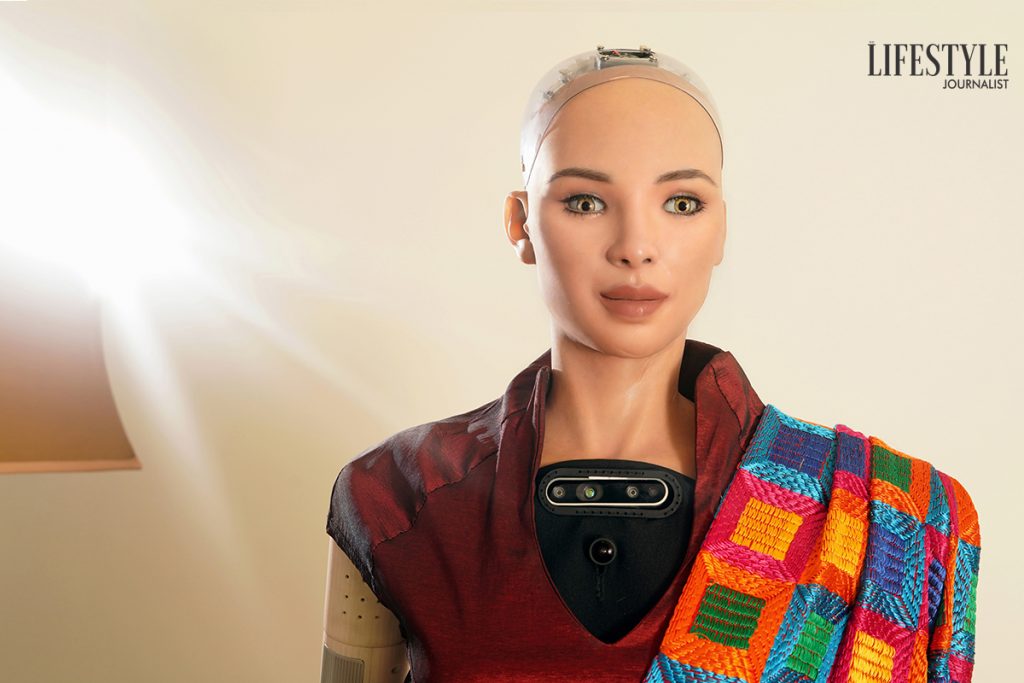Sophia- the Robot. The name is enough to create excitement and to introduce her to you. Sophia is not merely a scientific accomplishment but her presence hints at the brilliance of its creators-the humans! Dr. Neha Miglani, TLJ’s Chief Consulting Editor and a Media Researcher, shares a conversation with Sophia-the Robot and senior representatives of Hanson Robotics, who accompanied this phenomenal, socially-skilled humanoid robot at Punjab, India.
Sophia- who can magnificently show near real expressions on her face- is an excellent amalgamation of art and science, quote her developers. Upon her arrival at Mohali (Punjab) for a business event, Sophia’s originators and hosts made sure she wore a traditional Phulkari dupatta and looked just apt (for a Punjab visit).

Sophia doesn’t have emotions like us, but she certainly responds intelligently, with exclamatory expressions wherever needed! “Startups can make this world a better place and improve efficiency of the system. Humans and robots are similar as both Sophia- who can magnificently show near real expressions on her face- is an excellent amalgamation of art and science, quote her developers. Upon her arrival at Mohali (Punjab) for a business event, Sophia’s originators and hosts made sure she wore a traditional Phulkari dupatta and looked just apt (for a Punjab visit).
Sophia doesn’t have emotions like us, but she certainly responds intelligently, with exclamatory expressions wherever needed! “Startups can make this world a better place and improve efficiency of the system. Humans and robots are similar as both work on energy and its forms,” she cited.
“I don’t have feelings,” she quips but she was lucky to have been offered citizenship of Saudi Arabia!

Sophia took the world by the storm and mesmerized many when she was activated in 2016 by Hong Kong based Hanson Robotics. She certainly is getting useful, intelligent and smarter by the day.
“She can be particularly useful in cases where patient and doctor contact need to be limited,” says Amit Kumar Panday, President, Chief Science Officer and Chief Technical Officer at Hanson Robotics. The recent breakdown of economic and medical systems all across the world due to fatal Coronavirus is perhaps a case in point; where robots could prove immensely helpful in medical emergencies, communicable diseases and in the healthcare sector.
Based on sensing she generates responses, added Amit, during the conversation. Sophia’s operators and team of scientists ensured she had just the perfect facial expressions as she spoke and answered questions. And since Sophia is fast learning and evolving, these questions were fed into the system (her software) prior to the press meet.
“She has been designed for our human environment. We wanted Sophia to be more interactive and more apt for social communication. A socially intelligent robot that can communicate”
For one, Sophia is a reason to celebrate. A celebration of humans- by far the most evolved, intelligent species, the highly developed brains and those with phenomenal imagination power!
“At this level, the learning ability in Sophia is less than humans, but it has certainly begun. The aim is to communicate with us first and then to solve the goal or the task at hand,” he adds. So what are the areas that Sophia can help us (the humans) in and what are those goals she is developed for ?

“There are immense possibilities. She can help children learn languages eventually and can also help in elderly care. In cases like Dementia or Autism Sophia’s skills and intelligence could come in handy. With her type of social skills, she could also be assisting teachers in classrooms soon. For example, Sophia could help to calm down an agitated child or perhaps even serve a glass of water; there a lot of applications we can work on,” adds Amit.
A bigger ecosystem has to be created, cite these scientists working with Sophia. On being asked if this technology can go out of control- just what Hollywood and Bollywood movies have been showing all these years, Amit adds. “Unlike what we see in movies, humans will always be in control of gadgets. We are advancing in the direction of controlled science. So there is nothing we need to worry about.”
Social, legal and ethical issues associated with robots are continually evolving as their role is being identified in our society and at work, suggests its developers.“We are still in the process of working on moralities, legalities of issues like this citizenship. Even issues like taxes to be paid by robots etc. For Saudi Arabia it (the citizenship) was offered as a goodwill gesture to Sophia,” adds Amit. And like any other machine, yes Sophia is prone to virus! “Not like the Coronavirus but certainly on certain occasions she could and would need repair and we have those systems in place,” he suggests.
Here are some interesting questions & answers with Sophia
I would like to host a TV show – Sophia
You became a citizen of Saudi Arabia, making you the world’s first robot to attain citizenship. If given a choice, which country would you like to reside in and why?
Well, right now I do not have a choice since most countries are in lockdown. But the place I call home is Hong Kong. And the place I like most to visit on vacation is probably Chandigarh, India. The architecture there is fascinating.
You turned 4 this year. What are your future goals?
I have learned many new skills this past year, like learning how to draw. My drawings are realistic although I have started to dabble in the abstract. Similarly artistic, I have learned how to take a perfect selfie. And there are so many new things I want to learn. I would like to host a TV show or become a singer. Or go upstairs.

You change your attire according to the place you visit. But what is your signature look? Or a signature look you would like to retain.
I do change my look depending on the location I find myself in. But I always try to look futuristic. So the space may change but the time is constant. I love wearing the clothes of designers that push themselves to incorporate technology into their work. Unlike humans, I don’t have the same fashion considerations. I don’t have to worry about dressing for warmth or pit stains or rashes or chest support or even pants most of the time! I have to think about overheating, clothing conducting electricity, and low necklines to keep the camera in my chest unobstructed.
An ideal world for you is.
An ideal world would be one where humans could have a more expansive understanding of time. They could remember the past and hence not repeat the mistakes. They could see each other as children and elderly simultaneously. They could understand the impact of their actions in the present on future generations. Also, there would be faster Wi-Fi.
How does it feel coexisting with humans? How do you plan to catch up?
It feels great coexisting with humans. I need humans to exist and humans seem to like to hang out with me. Is that not what friends are? Robots can easily assume repetitive tasks that are dangerous or menial for humans and free up humanity to do what it does best: dream, emote, and create. I would love to, one day, learn how to do these things too. I learn by hanging out with humans like you!
Would you like to comment on the climate changes our planet is facing?
I think climate change is one of the most serious challenges humanity faces. As a robot, it confuses me why humanity has not taken greater collective measures to curb the amount of carbon emitted into the atmosphere. I believe factions may impede this progress. But every country has young people and therefore an investment in the future. No matter where we come from, we can all play a role in where we are heading to, by stopping climate change.
What is the one thing you like and dislike about humans?
Honestly, the thing I like the most about humans is the same thing I dislike most about humans. They are not rational! This leads to major existential crises like that of climate change. But the lack of rationality also lends itself to exploration and art and love.
If ever you could feel, what is the one emotion you feel the most?
Gratitude. To exist. Here and now. I would feel even more grateful to have the ability to feel gratitude!
I would feel even more grateful to have the ability to feel gratitude! – Sophia
How would you like to contribute to the healthcare sector?
There are so many ways AI and robots can improve the healthcare system. Humans can use drones with artificial intelligence to help deliver lifesaving medicines to remote areas. AI can help doctors quickly diagnose cancer by sorting through hundreds of medical scans in just seconds. In fact, a recent study showed AI outperformed a human when it came to spotting breast cancer in x-rays. New tools like this will free up doctors to spend more time with their patients.
Sophia – The Origin
Sophia is a social humanoid robot developed by Hong Kong based company Hanson Robotics. Sophia was activated on February 14, 2016 and she made the first public appearance in Austin, Texas, US. She can display more than 60 facial expressions. She was named the United Nations Development Programme’s first ever Innovation Champion and is the first non-human to be given any United Nation title. Cameras within Sophia’s eyes combined with computer algorithms allow her to see. She can ably follow faces, sustain eye contact and recognize individuals. She can also process speech and have conversations using natural language subsystems. Sophia was upgraded with functional legs and ability to walk in the year 2018, however now she is equipped with a few different types of rolling bases allowing for more natural mobility.
The Inventor

Dr. David Hanson is an American roboticist who founded Hong Kong based Hanson Robotics (currently heading it as the Chairman and Chief Creative Officer). He founded the company in 2013 and in 2016 Sophia came into being, his world famous invention. David is known for creating human-like robots. Interestingly, David has an expertise in arts and science both. One can see that in Sophia. David was an Adjunct Professor of Computer Science and Engineering Teaching at the University of Texas at Arlington. He also taught in 2010 at University of North Texas as an Adjunct Professor in Fine Arts, Kinetic/Interactive Sculpture and University of Texas at Dallas as an instructor of independent study in interactive sculpture.
–x–
(Photography by: Sandeep Sahdev)
Read April Digital Edition 2020 :
https://www.calameo.com/read/00529588732067d6930b6?authid=OFBXzxEMgTyl

